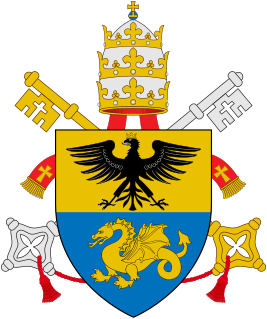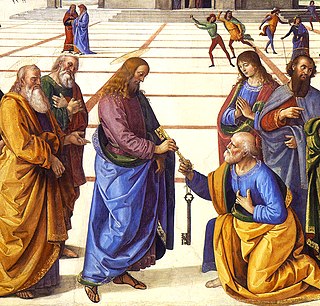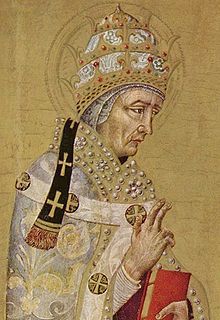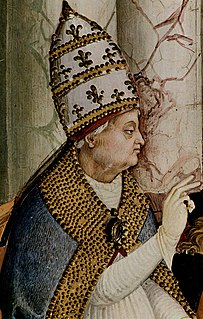Related Research Articles

The Inquisition was a group of institutions within the Catholic Church whose aim was to combat heresy, conducting trials of suspected heretics. Studies of the records have found that the overwhelming majority of sentences consisted of penances, but that cases of repeat unrepentant heretics were handed over to the secular courts, which generally resulted in execution or life imprisonment. The Inquisition had its start in the 12th-century Kingdom of France, with the aim of combating religious deviation, particularly among the Cathars and the Waldensians. The inquisitorial courts from this time until the mid-15th century are together known as the Medieval Inquisition. Other groups investigated during the Medieval Inquisition, which primarily took place in France and Italy, include the Spiritual Franciscans, the Hussites, and the Beguines. Beginning in the 1250s, inquisitors were generally chosen from members of the Dominican Order, replacing the earlier practice of using local clergy as judges.

Pope Clement X, born Emilio Bonaventura Altieri, was head of the Catholic Church and ruler of the Papal States from 29 April 1670 to his death in 1676. Elected pope at age 79, he has since been ranked as the oldest pope at the time of his election.

Pope Paul V, born Camillo Borghese, was head of the Catholic Church and ruler of the Papal States from 16 May 1605 to his death. In 1611, he honored Galileo Galilei as a member of the Papal Accademia dei Lincei and supported his discoveries. In 1616, Pope Paul V instructed Cardinal Bellarmine to inform Galileo that the Copernican theory could not be taught as fact, but Bellarmine's certificate allowed Galileo to continue his studies in search for evidence and use the geocentric model as a theoretical device. That same year Paul V assured Galileo that he was safe from persecution so long as he, the Pope, should live. Bellarmine's certificate was used by Galileo for his defense at the trial of 1633.

Pope Paul IV, born Gian Pietro Carafa, C.R. was head of the Catholic Church and ruler of the Papal States from 23 May 1555 to his death in 1559. While serving as papal nuncio in Spain, he developed an anti-Spanish outlook that later coloured his papacy. In response to an invasion of part of the Papal States by Spain during his papacy, he called for a French military intervention. After a defeat of the French and with Spanish troops at the edge of Rome, the Papacy and Spain reached a compromise: French and Spanish forces left the Papal States and the Pope thereafter adopted a neutral stance between France and Spain.

Tomás de Torquemada, also anglicized as Thomas of Torquemada, was a Castilian Dominican friar and first Grand Inquisitor in Spain's movement to homogenize religious practices with those of the Catholic Church in the late 15th century, otherwise known as the Spanish Inquisition.

Pedro de Arbués was a Spanish Roman Catholic priest and a professed Augustinian canon. He served as an official of the Spanish Inquisition until he was assassinated in the La Seo Cathedral in Zaragoza in 1485 allegedly by Jews and conversos. The veneration of him came swiftly through popular acclaim. His death greatly assisted the Inquisitor-General Tomás de Torquemada's campaign against heretics and crypto-Jews.

Diego de Deza y Tavera was a theologian and inquisitor of Spain. He was one of the more notable figures in the Spanish Inquisition, and succeeded Tomás de Torquemada to the post of Grand Inquisitor.

Juan de Torquemada, O.P., , Spanish ecclesiastic, defender of Jewish conversos, has been described as the most articulate papal apologist of the fifteenth century. He was an uncle of Tomás de Torquemada, afterwards notorious as the persecuting Grand Inquisitor.

Pedro Martínez de Luna y Pérez de Gotor, known as el Papa Luna in Spanish and Pope Luna in English, was an Aragonese nobleman, who as Benedict XIII, is considered an antipope by the Catholic Church.

Lope de Barrientos (1382–1469), sometimes called Obispo Barrientos, was a powerful clergyman and statesman of the Crown of Castile during the 15th century, although his prominence and the influence he wielded during his lifetime is not a subject of common study in Spanish history.

The Tribunal of the Holy Office of the Inquisition, commonly known as the Spanish Inquisition, was established in 1478 by the Catholic Monarchs, King Ferdinand II of Aragon and Queen Isabella I of Castile. It began toward the end of the Reconquista and was intended to maintain Catholic orthodoxy in their kingdoms and to replace the Medieval Inquisition, which was under Papal control. It became the most substantive of the three different manifestations of the wider Catholic Inquisition along with the Roman Inquisition and Portuguese Inquisition. The "Spanish Inquisition" may be defined broadly as operating in Spain and in all Spanish colonies and territories, which included the Canary Islands, the Kingdom of Naples, and all Spanish possessions in North, Central, and South America. According to modern estimates, around 150,000 people were prosecuted for various offences during the three-century duration of the Spanish Inquisition, of whom between 3,000 and 5,000 were executed.

An ecclesiastical judge is an ecclesiastical person who possesses ecclesiastical jurisdiction either in general or in the strict sense. Up until 1858 when Ecclesiastical courts were abolished, ecclesiastical judges tried church clergy men in church courts or Ecclesiastical courts. Charges dealt in these courts were often very lenient, especially when dealt to church clergymen.
The Church policies after World War II of Pope Pius XII focused on material aid to war-torn Europe, the internationalization of the Roman Catholic Church, its persecution in Eastern Europe, China and Vietnam, and relations with the United States and the emerging European Union.

The selection of the pope, the bishop of Rome and supreme pontiff of the Roman Catholic Church, prior to the promulgation of In nomine Domini in 1059 varied throughout history. Popes were often appointed by their predecessors or by political rulers. While some kind of election often characterized the procedure, an election that included meaningful participation of the laity was rare, especially as the popes' claims to temporal power solidified into the Papal States. The practice of papal appointment during this period would later result in the jus exclusivae, i.e., a right to veto the selection that Catholic monarchs exercised into the twentieth century.

The 1458 papal conclave, convened after the death of Pope Callixtus III, elected as his successor Cardinal Enea Silvio Piccolomini who took the name Pius II.
The doctrines of Petrine primacy and papal primacy are perhaps the most contentiously disputed in the history of Christianity. Theologians regard the doctrine of papal primacy as having gradually developed in the West due to the convergence of a number of factors, e.g., the dignity of Rome as the only apostolic see in the West; the tradition that both Peter and Paul had been martyred there; Rome's long history as a capital of the Roman Empire; and its continuing position as the chief center of commerce and communication.

Rinaldo d'Este was an Italian Catholic Cardinal.
The Eastern Orthodox Church is opposed to the Roman Catholic doctrine of papal supremacy. While not denying that primacy does exist for the Bishop of Rome, Eastern Orthodox Christians argue that the tradition of Rome's primacy in the early Church was not equivalent to the current doctrine of supremacy.
Pedro Rodríguez de Quexada or Petrus Hispanus was an ecclesiastic from Castile.
Martino Alfieri or Alferi was Apostolic Nuncio to Cologne from 1634 to 1639 and he served also as Bishop of Isola and Archbishop of Cosenza.
References
- Heinrich Grätz, Gesch. der Juden, 3d ed., viii.318, 385
 This article incorporates text from a publication now in the public domain : Singer, Isidore; et al., eds. (1901–1906). "Aranda, Pedro de". The Jewish Encyclopedia . New York: Funk & Wagnalls.
This article incorporates text from a publication now in the public domain : Singer, Isidore; et al., eds. (1901–1906). "Aranda, Pedro de". The Jewish Encyclopedia . New York: Funk & Wagnalls.